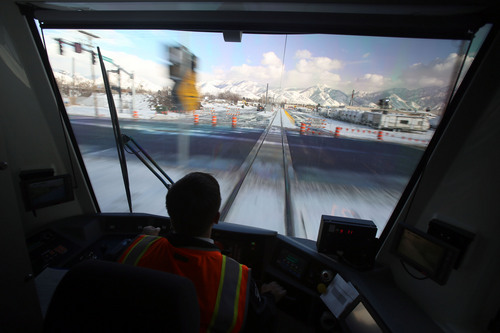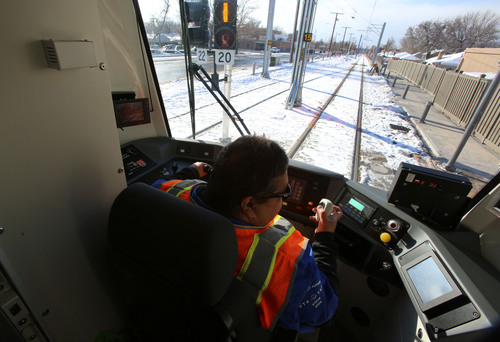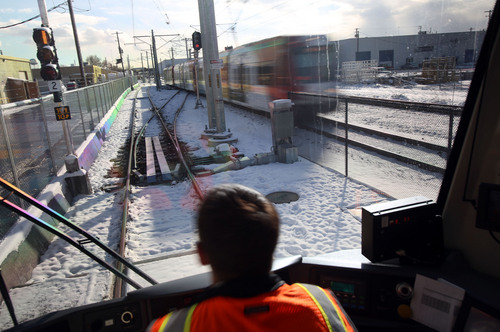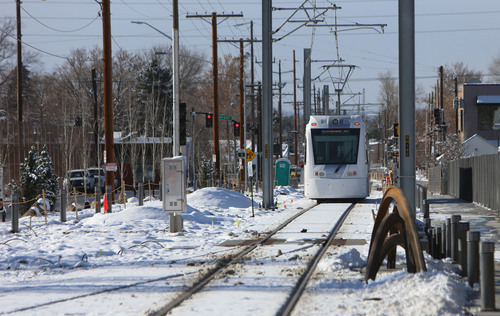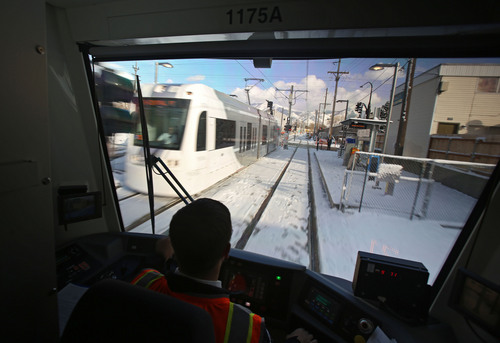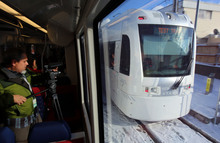This is an archived article that was published on sltrib.com in 2013, and information in the article may be outdated. It is provided only for personal research purposes and may not be reprinted.
Unlike fast TRAX and even more rapid FrontRunner trains, the new Sugar House Streetcar cruises leisurely at about 15 mph — and reaches a maximum of only 25 mph.
While fences and barbed wire keep pedestrians away from TRAX and FrontRunner tracks for safety, the new streetcar is in the middle of what essentially will become a long park. It is an historic rail corridor with new bike and walking trails near tracks, along with sculptures, greenery and even bocce ball courts.
"It's pretty exciting that an old rail corridor is going to carry a streetcar plus all these amenities," said Jim Webb, project manager for the Utah Transit Authority. "It's more like a linear park next to a streetcar. It's something akin to the River Walk in San Antonio. It's a boat you ride there. This is a train."
UTA officials showed off the new streetcar — officially called the S-Line — to the news media on Wednesday before its grand opening ceremonies on Thursday, and its opening to the public on Saturday, when anyone who brings a can of food for the needy will be given free fare.
The line begins regular service on Sunday. As a promotion, UTA is offering $1 fares on the line to anyone who pays with electronic media such as UTA Farepay cards. The regular cash fare on the line is $2.50, the same as on other UTA TRAX and bus service.
The new streetcar allows easy transfers to TRAX at the Central Pointe Station on 2100 South. The streetcar travels eastward for two miles — with seven stops, spread about every two blocks — to Fairmont Park in Sugar House. The two-mile trip takes about 13 minutes.
Webb explains that the streetcar will offer a different transit experience than its other trains and buses.
Part of that is its slow speed. It is needed because the corridor has no gates or flashing guard signs, just stop signs and traffic signals. The only separation between streetcars and people on trails will be a hedge (and until it grows more, a temporary fence).
The slow speed allows the train to stop in much shorter distances than other UTA trains, said Max Hanna, a UTA safety administrator. During the testing phase, some cars have not been stopping at stop signs as trains approached. Also, a car that ran a traffic signal at 700 East hit a streetcar. "So we are urging people to pay attention to the stop signs," he said.
Webb says the slow speed — and the amenities that allows — also fits better with the neighborhood.
"That's what the community wanted, a system that's friendly to their neighborhood that's been here for 100 years," Webb said. "They've always wanted to keep this Sugar House feel of being a quiet neighborhood, and that's what we've tried to do."
The streetcars are single vehicles and will never be connected as multi-car trains. So their platforms are short — 60 feet, just long enough for the one car. In comparison, Webb said TRAX platforms are about 350 feet long. UTA also calls the streetcar platforms "stops" instead of "stations" because they are so short.
The streetcars vehicles are exactly the same as the newer TRAX cars used on the green and red lines. "They are identical, except that the ends of the train have a shroud that makes them feel more like a streetcar," Webb said. That shroud is essentially a bumper that replaces coupler hitches on TRAX vehicles.
The joint project by UTA, Salt Lake City and South Salt Lake cost $37 million, with $26 million coming from a federal grant designed to spur economic recovery, Webb said. Salt Lake City has been discussing extending the streetcar line, perhaps eventually to the University of Utah.
Webb says that even before the streetcar is finished, it has been a magnet for new development.
On the Sugar House end, he said, there is "a lot of vertical, mixed-use development going up — condos, commercial business. It's really started sprouting already on that end. South Salt Lake has already a huge planned area down there called Central Pointe near the Main Street stop." —
Sugar House Streetcar opening
Grand opening • Ceremonies on Thursday at 2:30 p.m. at the Fairmont Stop, 2216 McClelland Street, feature speakers including Federal Transit Administrator Peter Rogoff.
Public preview • On Saturday, free rides on the line are offered to people who donate a can of food for the needy from 10 a.m. to 6 p.m.
Regular service • Begins Sunday. Promotional $1 fares are available to those who pay by electronic fare media such as UTA's Farepay cards.


